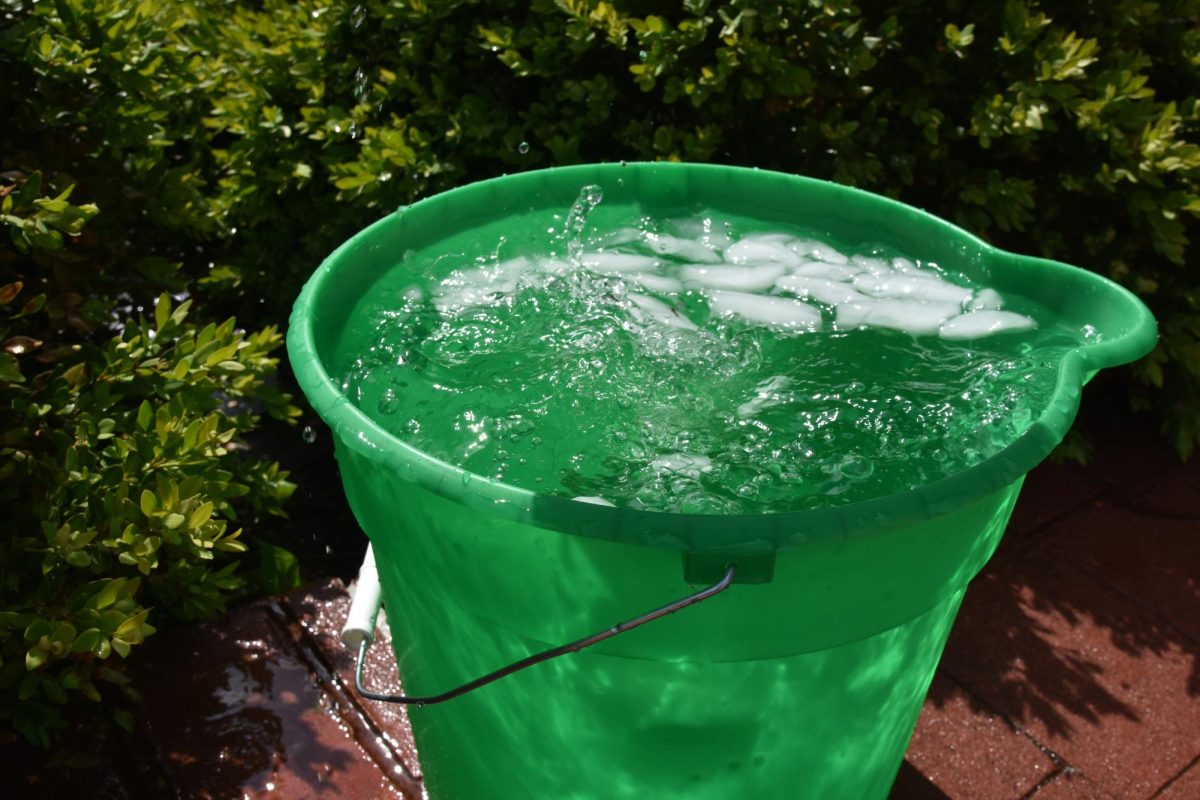It is 2:30 p.m. and school is out for the weekend. As students of the Child Development class head home, they lug their backpacks, car seats and baby. As part of the class, students are required to care for an interactive baby for 14 hours.
The babies have a sensor that is paired with a bracelet worn by the student. When the baby cries, the student is required to put the bracelet to the baby’s sensor to simulate that the child is being cared for within a two minute time frame. If the sensor on the baby is not scanned in that time, points are lost on the assignment. Freshman Sarah Griege felt the pressure to care for the baby in time.
“I put a blanket down on the floor and made sure that the baby’s neck was cradled, and then I was trying to find the sensor, but I couldn’t find it. I thought it had been scanned,” Griege said. “I did everything–burped it, rocked it, fed it, changed its diaper and clothes–nothing worked. I was getting nervous because I had no idea what was wrong. I eventually found the scanner, and it worked, but it took a solid five minutes.”
Griege was not the only student who had to use multiple methods to calm the baby.
“I had tried everything we were taught to do, but my baby would not stop crying,” senior Madi Foppe said. “I then started walking around my house while rocking her to see if it would help. Eventually, she stopped crying and fell asleep.”
The continuous crying of the baby is intended to teach students to respond quickly, but it can put more stress on students, including the loss of sleep.
“The baby was so needy,” Griege said. “I thought, ‘oh my gosh, am I doing it right?’ I was so anxious about it. Even when I was about to go to sleep, I knew it was going to cry soon so I just didn’t go to sleep.”
Worries about sleep were a common theme in caring for the interactive baby.
“It raised my stress level for sure because I was always worried that I was going to do something wrong, especially in the night,” Foppe said. “I was very worried to go to sleep. I know I am a deep sleeper, so I thought I wouldn’t wake up.”
According to Child Development teacher Renee Brommelsick, caring for the baby was not supposed to be a difficult assignment. However, what can seem like minor details of the baby’s care can be an important aspect of student’s grades. Because the sensor on the baby can be tracked by the teacher, any mistake made by a student is shown.
“If the baby is supposed to wake up four times at night for a bottle and you miss one, it’ll show me three out of four. If you never feed it, it shows zero out of four,” Brommelsick said. “But also, if you accidentally pick it up and do not support the head, you lose 3% every time that you’re not properly handling the baby, which is called a mishandle. For instance, if you put the baby on its stomach. Newborns aren’t supposed to be put to sleep on their stomach. That would be a mishandle, so it takes that percentage off.”
Mishandles were one of the biggest stressors for students.
“I was very nervous because there are many things you would have to do under a certain amount of time when the baby starts to cry. You also have to make sure not to jerk the head causing shaken baby syndrome,” Foppe said.
Brommelsick often asks students to report their stories of what they encounter when bringing the baby out in public.
“They think it’s a real baby. People will come up at a restaurant and then get startled when it’s a fake baby,” Brommelsick said. “A student had it in the car and the door was shut, and someone freaked out because they thought a real baby was in the car.”
Brommelsick has had students return after their 14 hours of parenting insisting they never want to have children.
“That is not my goal,” Brommelsick said. “I just want them to know that it’s harder than it seems. You just need to be aware that it’s a responsibility.”
Had the assignment been for a longer timespan, it would have further imitated the care for a real baby.
“The tasks we had to perform while caring for the baby are similar to a real baby,” Foppe said. “The experience prepared me in some way, but it would need to be a much longer period to make it feel as if it were a real baby.”
Although the process was stressful for Griege, she recommends the class to others because she feels that it taught her important lessons.
“It was nerve-wracking when [the baby] was crying, and you just had to try everything to make it work under pressure,” Griege said. “But I think it has really good, valuable life lessons to prepare students for the future.”




![Smiling in a sea of Longhorns, Fox 2 reporter Ty Hawkins joins junior Darren Young during the morning Oct. 3 pep rally. The last time West was featured in this segment was 2011. “[I hope people see this and think] if you come to [Parkway] West, you will have the time of your life because there are so many fun activities to do that make it feel like you belong here. I was surprised so many people attended, but it was a lot of fun,” Young said.](https://pwestpathfinder.com/wp-content/uploads/2025/10/Edited2-1200x798.jpg)
![West High seniors and families listen as a representative of The Scholarship Foundation of St. Louis, Teresa Steinkamp, leads a Free Application for Federal Student Aid (FAFSA) workshop. This session, held in the library, provided guidance on financial aid, scholarships and student loan options. “This event is very beneficial for any seniors who are applying to or considering applying to colleges after high school [because] the cost of college is on the rise for seniors and parents,” college and career counselor Chris Lorenz said.](https://pwestpathfinder.com/wp-content/uploads/2025/09/DSC_4478-1200x778.jpg)
![Senior Kamori Berry walks across the field during halftime at the Homecoming football game on Sept. 12. During the pep assembly earlier that day, she was pronounced Homecoming Queen. “I thought it was nice that the crowd [started] cheering right away. I know [my friends] were really excited for me, and my family was happy because typically non-white people don't win,” Berry said.](https://pwestpathfinder.com/wp-content/uploads/2025/09/DSC7046-Enhanced-NR-1200x798.jpg)



![Pitching the ball on Apr. 14, senior Henry Wild and his team play against Belleville East. Wild was named scholar athlete of the year by St. Louis Post-Dispatch after maintaining a high cumulative GPA and staying involved with athletics for all of high school. “It’s an amazing honor. I feel very blessed to have the opportunity to represent my school [and] what [it] stands for,” Wild said.](https://pwestpathfinder.com/wp-content/uploads/2025/05/unnamed-6-1200x714.jpg)
![The Glory of Missouri award recipients stand with their certificates after finding out which virtue they were chosen to represent. When discovering their virtues, some recipients were met with contented confirmation, while others, complete surprise. “I was not at all surprised to get Truth. I discussed that with some of the other people who were getting the awards as well, and that came up as something I might get. Being in journalism, [Fellowship of Christian Athletes and] Speech and Debate, there's a culture of really caring about truth as a principle that I've tried to contribute to as well. I was very glad; [Truth] was a great one to get,” senior Will Gonsior said.](https://pwestpathfinder.com/wp-content/uploads/2025/04/Group-Glory-of-Missouri.jpg)

